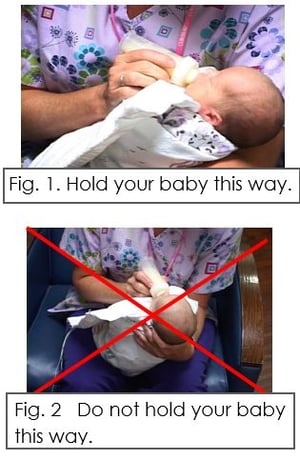Early positive experiences provide a positive base for successful feedings. This starts before oral feeding begins. Some things you can do to help are:
- mouth cares with expressed breast milk.
- Kangaroo care.
- help your baby use a pacifier. This is called non-nutritive sucking.
Before all oral feeding:
Turn on the indirect lights about 1/2 hour before you want to feed your baby. This lets your baby gently wake on their own.
A baby must show 3 signs that they are ready to eat before you start oral feedings. These signs are called readiness cues. Your baby needs to:
1. maintain energy by keeping arms and legs close to body.
2. open and move their mouth towards a pacifier and start to suck on it. This is called the rooting reflex.
3. have normal color and breathing.
Often, you will see these cues around 32 to 35 weeks old. Your baby may not be able to coordinate the suck, swallow and breathe until 37 weeks old.
When all three readiness cues are present, you should start the feeding.
- Swaddle and cradle your baby in your arms against your body. See Fig 1.
- Don’t hold the baby in front of you under the back of the neck. This makes it hard to swallow. See Fig 2.
- Give your baby a pacifier to suck. This helps your baby learn to how to breathe when sucking.
- Focus on the baby during the feeding. Make this a quiet time to bond.
During the feeding your baby will need to coordinate sucking, swallowing and breathing.
- Watch for your baby’s readiness cues.
- Watch your baby’s sucking patterns. You should see 1 or 2 sucks then swallowing.
- Watch for stress cues.
What are stress cues?
- Stop Sign (fingers extend).
- Stretches out arms or legs.
- Bites or closes mouth tight.
- Looks away from you while eating.
- Hiccups.
- Drools.
- Gags or vomits.
- Gulps.
- Coughs or chokes.
- Bobs their head.
- Raises the eye brows.
- Changes color.
- Swallows too fast and too often.
- Pulling in of the muscles between ribs.
- Blinks quickly.
- Is crabby or upset.
- Starts to breathe fast.
- Arches their back or body.
- Nostrils open bigger or wider when breathing in. This is called nasal flaring.
- Makes a high-pitched crowing sound
- Starts to gasp.
- Looks worried or frowns
- Stops breathing.
If the infant shows stress cues:
- Pause the feeding to let your baby reorganize.
- Give breaks or pace the feed.
- Try a pacifier or a finger for sucking to help quiet, calm or wake your baby.
- Burp your baby.
- Your baby needs to show the three readiness cues again to re-start oral feeding. If all three cues are present, start the feeding. If not, take a break and try again. If this happens a lot your baby may need to be tube fed. You should hold your baby during the tube feeding.
Your baby is finished feeding when they:
- Do not show the three readiness cues.
- Fall asleep and stop sucking.
- Show stress cues after a few attempts to re-start feedings.
- Will only suck on the pacifier and stops sucking on the breast or bottle. This is called non-nutritive sucking.
Feeding should last no longer than 20 to 30 minutes.




